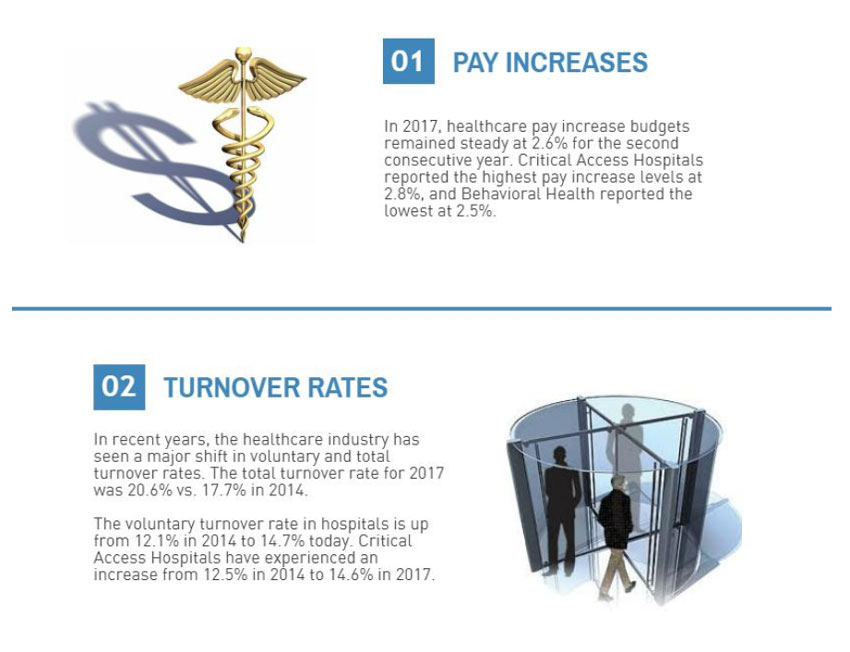
In 2017, the US healthcare industry’s voluntary turnover rates increased from 12.1% in 2014 to 14.7%. To combat the problem, more than half of all employers offered sign-on bonuses and 20.1% increased their starting rates. But, according to the 2017 Healthcare Compensation Trends, the healthcare industry is missing something somewhere.
According to survey data from LFT, hospitals replace nearly half of their workforce every five years. A shrinking talent pool only strains the already fragile state of the health care industry.
It looks like money isn’t enough to hold onto staff.

Employee attrition is expensive
Exactly how much does the loss of a staff member cost a hospital? The jury is out on exactly which methodology to use, but studies show that costs can range from $10,000 to as high as $88,000 per employee. Do the math and it’s easy to see that even a 5% hospital turnover rate isn’t easily dismissed.
What’s causing hospital turnover rates to be so high? And how should HR respond?
In our experience, any organization with an employee retention problem typically struggles to do one thing right: that is, to effectively integrate new hires.
A journal article, “Reducing Annual Hospital and Registered Nurse Staff Turnover—A 10-Element Onboarding Program Intervention” explains how an effective employee integration program can make a big difference.
Doing it right the first time
While it’s devastating to see good employees leave, it’s worse to learn that your organization was never equipped to help them thrive.
According to a survey of hospital staff exit interviews, almost 52% of new employees felt that their hospital orientation did not provide the necessary information for successful employment. Employees reported that they had no-one to turn to with their concerns, and that they lacked a realistic understanding of the job and its responsibilities.
Have your exit interviews presented similar results?
Well-planned and executed employee integration programs foster a culture of inclusion, create a positive work environment, and drive staff to engage with each other regularly. This leads to a workforce of people who want to stay and contribute.
According to “Reducing Annual Hospital and Registered Nurse Staff Turnover—A 10-Element Onboarding Program Intervention,” the introduction of an onboarding program made a considerable difference. Hospital turnover rates decreased by 6.3% in 12 months.
The onboarding program included the following:
- A new employee profile (NEP), which provides information about all new hires in departmental listings to help older staff be on the lookout for the new hires and forge relationships with them.
- A new hire packet was introduced, which includes a complete NEP, and blank checklists and evaluation forms to be used in the 90-day onboarding cycle.
- A copy of the new hire’s offer letter confirming employment, start date, salary, and the steps to be completed in the onboarding process.
- A required communications plan which includes a welcome call from the hiring manager to the new hire, an email to all staff welcoming the new starter, and regular communication with the hiring manager.
- An administrative checklist for directors and managers to ensure that all new starters receive basic information during the first two weeks of their employment.
- Each new employee was assigned a work buddy (a high-performing staff member) for the 90-day onboarding window to offer guidance, advice, and encouragement on the job.
- An onboarding checklist that covers what new staff can expect during the first 30, 60, and 90 days.
- 30-, 60-, and 90-day interviews were conducted at each milestone to assess job fit, work environment, and the need for any support. This proved instrumental in improving new hire work experiences.
- A 90-day evaluation by the hiring manager of the new hire’s work performance.
- A quarterly spotlight event where the CEO and new hires meet to assess the hospital’s onboarding process.
How to strengthen your hospital’s onboarding program
You can use something like the 10-element onboarding program above to create your own onboarding program. But how do you keep track of all the moving parts? And what if you’d like to add additional check-ins or engagements to your new hires’ onboarding processes?
Previously, most of the heavy lifting in the employee integration process was handled by managers working from Excel spreadsheets. The problem is that managers are busy and constantly updating a spreadsheet is time consuming and leaves room for error.
vi’s Employee Integration and Retention solution is designed to help hospitals manage the entire employee onboarding process efficiently. You’ll be able to build your own employee integration plan that doesn’t stop at 90 days, or you can pick a program one from a collection of best-practice templates which have been proven to yield positive results.
You’ll also be able to schedule welcome calls and mentor meetings, present diversity and inclusion opportunities and activities, foster the right social connections, get real-time feedback – and everything is available to keep tabs on through a beautifully-designed dashboard that quickly shows you what needs attention.
Show your healthcare staff that they matter
We’d love to take you through a short demonstration of our Employee Integration and Retention solution and how you can begin to realize the value of a structured approach to creating a more empowered workforce. To book a time, just follow the link below and leave your details